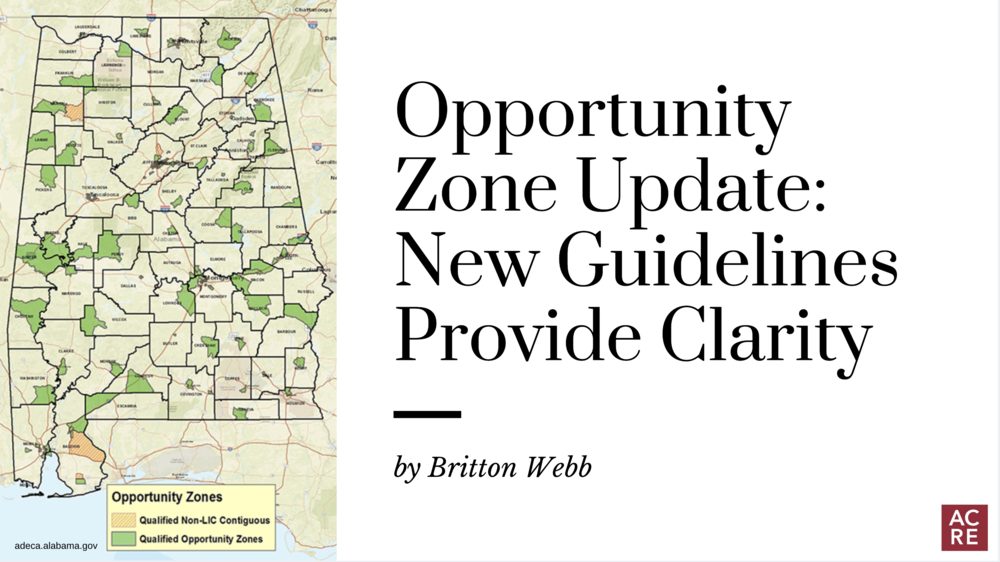Recently, the Trump administration released 74 pages of new proposed regulations for opportunity zones geared toward increasing tax-advantaged investments in low-income areas. Before delving into the new regulations, it’s crucial to understand how opportunity zones work. Individuals, C corps, S corps, partnerships, trusts, estates, and REITs, can all participate in opportunity zone investments. Each state can designate up to 25 percent of their low-income communities as opportunity zones. The state of Alabama has 158 designated opportunity zones (find a detailed report and map for each county here). A census tract qualifies as a “low-income community” if it meets one of these three criteria: 20 percent poverty rate, median family income below a certain threshold, or a population of fewer than 2,000 people and classified as an empowerment zone (economically distressed communities designated by the government for aid). Unlike a 1031 exchange, this process allows investors to defer capital gains from investments that do not include real estate. Currenlty, these deferred capital gains must be invested in a qualified opportunity fund (QOF) within 180 days of the sale of their stock, business, property, etc. However, the capital gain must come from the sale of an asset occurring after December 31, 2017, and before December 31, 2027.
Visit ACRE’s Opportunity Zone Research page for more information about opportunity zone resources and specific information about each Alabama county.
A qualified opportunity fund is organized for the specific purpose of investing in qualified opportunity zone property. Qualified opportunity funds must invest in qualified opportunity zone property by either owning qualified opportunity zone business property directly or indirectly by investing in a qualified opportunity zone business/subsidiary that owns qualified opportunity zone business property. If the fund owns property directly then 90 percent of the assets of the fund must be invested in qualified opportunity zone business property. If the fund operates indirectly then only 70 percent of the business/subsidiary’s assets must be invested in qualified opportunity zone business property. In other words, if the fund conducts business through a subsidiary, it can meet the qualified opportunity fund standards even though it has as little as 63 percent (90 percent x 70 percent) of its total assets invested in qualified opportunity zone business property. Qualified opportunity zone business property is tangible property that is acquired after December 31, 2017, which assures that a new investment is made into an opportunity zone.
In order for tax benefits to be recognized, capital gains must be invested in a qualified opportunity fund within 180 days. The gains can be tax-deferred until December 2026 at the latest. Once you hold the investment for 5 years, you get a 10 percent permanent deduction on that capital gain. If you hold the investment for 7 years, you’ll receive an additional 5 percent permanent reduction on that capital gain. This means that investors have to have their money invested in a qualified opportunity fund by December 31, 2019, in order to receive the 15 percent tax deduction. However, the benefit that has generated the most buzz is the 100 percent tax deduction on the investment appreciation if you hold for at least 10 years and up until December 2047. Here is an example to illustrate the tax benefits:
December 31, 2018: Invest $200,000 of capital gains in a qualified opportunity fund, deferring taxes until December 31, 2026.
December 31, 2023: After 5 years the investment basis increases 10 percent from $0 to $20,000 (10 percent x $200K).
December 31, 2025: After 7 years, the investment basis rises from $20,000 to $30,000 (15 percnet x $200K).
December 31, 2026: After 8 years, recognize $170,000 of deferred gain. Investment basis in the fund increases from $30,000 to $200,000.
December 31, 2030: After 12 years, sell the investment with a basis of $200,000 for $1 million. You pay no capital gains tax on the price appreciation.
The following chart shows an example of an opportunity fund investment compared to a standard stock portfolio with the scenario of a capital gain of $100 reinvested in 2018:

On October 19th, the Treasury released highly anticipated proposed regulations for opportunity zones. One of the new rules is the 70 percent rule briefly mentioned above. This addresses whether a business counts as having “substantially all” of its assets in an opportunity zone. As long as 70 percent of the business’s tangible property is in an opportunity zone, it doesn’t lose eligibility to qualify for the tax break. This is intriguing since 10 percent of the opportunity fund’s assets can already be invested outside of an opportunity zone. Which would imply that as little as 63 percent of the assets owned by a fund could be inside an opportunity zone. Another proposed guideline by the Treasury is a “working capital safe harbor” of 31 months. The capital will count as qualified opportunity zone business property as long as there is a plan in writing for the use of the capital, and a schedule for the capital to be spent within 31 months. This is a significant increase considering the initial rules required opportunity funds to deploy capital within 6 months of raising it. Furthermore, the Treasury addressed the initial guideline that required investors to spend at least the amount they paid for an asset on improvements. The new projected regulation only applies the original requirement to building value and excludes land value. This will facilitate more projects in higher land value urban areas. The new regulations also answer the question regarding debt investment in an opportunity fund. Debt investment is not a qualified investment in a fund, but the investor is allowed to collateralize a loan with an opportunity fund investment. Investors also gained clarity about the sale of a qualified opportunity fund. Capital gains from the sale of an opportunity fund can be deferred into another opportunity fund within 180 days.





